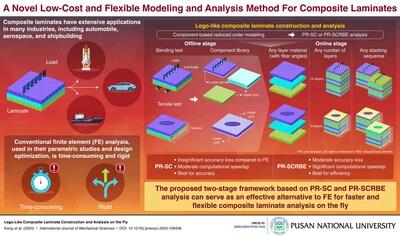(MENAFN- PR Newswire)
BUSAN, South Korea, Aug. 7, 2024 /PRNewswire/ -- Composite laminates, consisting of bonded layers of different materials, find extensive applications in various industries, including aerospace, automobiles, and shipbuilding sectors due to their exceptional strength-to-body-weight ratio and tailored mechanical properties. Due to different strength and properties resulted from different fiber directions, the design analysis and optimization of composite laminates requires repetitive numerical simulations to explore various layer materials and stacking sequences.
Continue Reading

The "Lego-like" construction and analysis method proposed in the study enables fast and accurate virtual testing of composite laminates, leading to optimal designs while saving time and material costs.
For such simulations, researchers typically use the renowned finite-element (FE) analysis based on three-dimensional (3-D) elasticity theory. However, the large degrees of freedom (DOF) of composite laminates make 3-D FE analysis resource-heavy, time-intensive, and impractical for repetitive simulations. Therefore, a numerical technique that is as accurate as FE analysis while being faster and more flexible, is needed.
Addressing these issues, Professor Kyunghoon Lee and Shinseong Kang from the Department of Aerospace Engineering at Pusan National University developed an innovative Lego-like construction and analysis method for composite laminates. "Inspired by substructuring and reduced order modeling (ROM) techniques, we developed a two-stage, offline-online framework that leverages component-based ROM. Like Lego bricks, our technique allows us to readily change layer materials including fiber angles, the number of layers, and their stacking sequence to build a composite laminate on the fly, enabling rapid yet accurate simulations," explains Prof. Lee. Their study was published in the International Journal of Mechanical Sciences on June 21, 2024.
In component-based ROM, complex systems are broken down into simpler subsystems that are individually analyzed using ROM. This ROM technique involves developing reduced models with lower DOFs. To achieve this goal, the researchers utilized static condensation (SC) combined with port reduction (PR) and reduced basis element (RBE) methods, leading to PR-SC and PR-SCRBE analysis methods. The SC method allows the stacking of any number of layers in any sequence as needed, by treating each layer of the composite laminate as a component. Next, the PR method reduces the DOFs of the connected boundaries of layers, accelerating the solution process. Lastly, the RBE method allows rapid and accurate evaluation of intradomain solutions of layers for the changes in layer materials.
This technique operates in two stages: the offline stage and the online stage. In the offline stage, a library of composite layers, parametrically representing various layer materials and fiber angles, is compiled. In the online stage, a composite laminate is constructed on demand by setting up the layer materials, fiber angles, and stacking sequence. This constructed laminate is then analyzed using the PR-SC method, or the
PR-SCRBE method if more computational efficiency is required than accuracy.
The researchers demonstrated the technique in a three-point bending test and a tensile test, assessing the accuracy and efficiency of the PR-SC and PR-SCRBE methods. For each example, they used three different composite laminates with different layers. Results revealed that the PR-SC analysis had negligible accuracy loss compared to the FE analysis while improving speed. On the other hand, PR-SCRBE showed moderate accuracy loss with a much larger improvement in speed. The researchers suggest employing PR-SC for accuracy and PR-SCRBE for efficiency as required.
"By utilizing the proposed technique for virtual testing of composites, we can identify optimal designs while minimizing time and material costs. Better composites can lead to lighter and stronger airplanes and automobiles with improved fuel economy and reduced pollution. Additionally, energy industries can utilize this technique to develop digital twins of assets," remarks a hopeful Prof. Lee.
Reference
Title of original paper:
Lego-Like Composite Laminate Construction and Analysis on the Fly
Journal:
International Journal of Mechanical Sciences
DOI:
href="" rel="nofollow" 1016/j.2024.10945
About the institute
Website:
Media Contact:
Jae-Eun Lee
82 51 510 7928
[email protected]
SOURCE Pusan National University
MENAFN07082024003732001241ID1108527394
Legal Disclaimer:
MENAFN provides the information “as is” without warranty of any kind. We do not accept any responsibility or liability for the accuracy, content, images, videos, licenses, completeness, legality, or reliability of the information contained in this article. If you have any complaints or copyright issues related to this article, kindly contact the provider above.